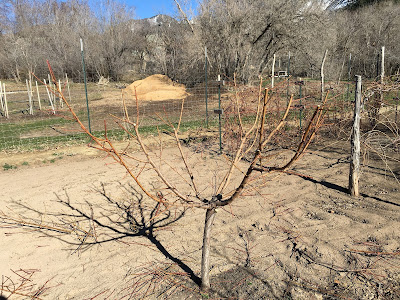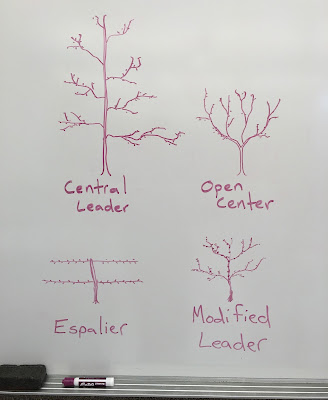4 Common Fruit Tree Pruning Forms
There are four common forms of fruit tree pruning and each one will give you different results. Each type of fruit tree will naturally have a different form and you can work with nature by using the best form for the tree variety that you are pruning. So, before you start pruning your fruit trees, ask yourself, "what exactly are you trying to accomplish?" If your trees are mature and they have not received regular pruning you may need to adjust your pruning plan to fit the current structure of your tree.
The four pruning forms are as follows:
Central leader pruning is a form of pruning in which the central leader of your fruit tree grows vertical and contains several layers of lateral branches that are evenly spaced to allow light to enter the center of your tree without being shaded by the surrounding branches. Central Leader Pruning is a great way to preserve the structural integrity of fruit trees. Central Leader Pruning is reserved for trees that are growing in tight spaces where the width of the tree must be contained, but the height of the tree does not have the same restraints. If fruit trees are pruned in a central leader form and are allowed to get too tall, future pruning, pest control, and harvesting with be more difficult.
Modified Leader is a hybrid between central leader and open center forms of pruning. A modified leader has the top portion of the leader removed, but retains multiple layers of strong lateral branches. A fruit tree with a modified leader will have restrains in both height and width. Modified leaders can reduce the height, maintain structural integrity, and allow for good light and airflow to the center of the tree, making this form of pruning good for backyard fruit trees that need regular pruning, pest control, and harvesting.
Open center pruning is the most common form of pruning for both commercial and residential fruit tree pruning. In open center pruning the leader of your fruit tree is completely removed while the tree is still young and three to five secondary branches are trained to grow up and out so that the center of the tree is open like a bowl. This form of pruning is designed to maximize fruit production while managing the overall height of the tree. An open center form of pruning, if done right, is extremely productive and will simplify future pruning, harvesting, and pest control.
 |
| Peach Tree with Open Center |
Espalier pruning is a form of pruning where your fruit tree is trained to grow flat against a wall or fence. Espalier pruning is both artistic and productive and a great way to conserve space. Espalier pruning is the most challenging form of the four common pruning forms mentioned in this blog post and requires a lot more maintenance than the other forms described here in.
 |
| Pear Tree in an Espalier Form |
All fruit tree varieties have slightly different habits. If you understand the four forms of fruit tree pruning and each fruit tree's natural habits, then you will be better prepared to work with nature and use the form that best fits the type of tree that you are pruning. For example, pear trees have a natural upright habit making central leader pruning a good choice. Peach and nectarine trees are very prolific and need lots of light, making an open center the best choice for these trees. Apples, plums, and cherries do well with a modified leader with two or three layers of secondary branches. Any fruit tree can be pruned using any on the these four pruning forms even if some pruning forms are better suited for some fruit tree varieties.
When pruning fruit trees, it is important to ask yourself, "what exactly are you trying to accomplish?" If you have restrains of height or width, these restraints will help you determine whether to use a central leader form or a modified leader form. If you are trying to maximize fruit production, then an open center might be the best pruning form for your tree. If you have a formal garden with an empty wall, then espalier pruning might be the best form of pruning to add interest to your landscape.
For more information about the care and pruning of fruit trees, please subscribe here:
Deciding which form of pruning to use on your fruit trees should be done when the tree is still young and each year you should prune your tree to fit this form. In some cases fruit trees are neglected for years and the tree has been left to grow unchecked. To minimize the stress and to allow your tree to heal properly, it is important to inspect an unpruned, mature tree and decide what form of pruning will best fit its current form to avoid removing branches that are too large.
 |
| Mature Apple Tree with an Established Form |
Whether you are pruning a mature tree with an established structure or you want to accomplish a certain goal with your fruit trees, it is important to understand the tree's natural habit and to learn about the different pruning forms available. Your results will vary based on any of these four forms of pruning.
If you would like to learn more about the care and pruning of fruit trees, please browse our 100+ fruit tree articles here, join our Backyard Fruit Growers Facebook Group, and take our free Fruit Tree Pruning Course. Also, please subscribe to our Fruit Pruning YouTube Channel.






Interesting. Thank you!
ReplyDeleteThanks ASo'P!
Delete